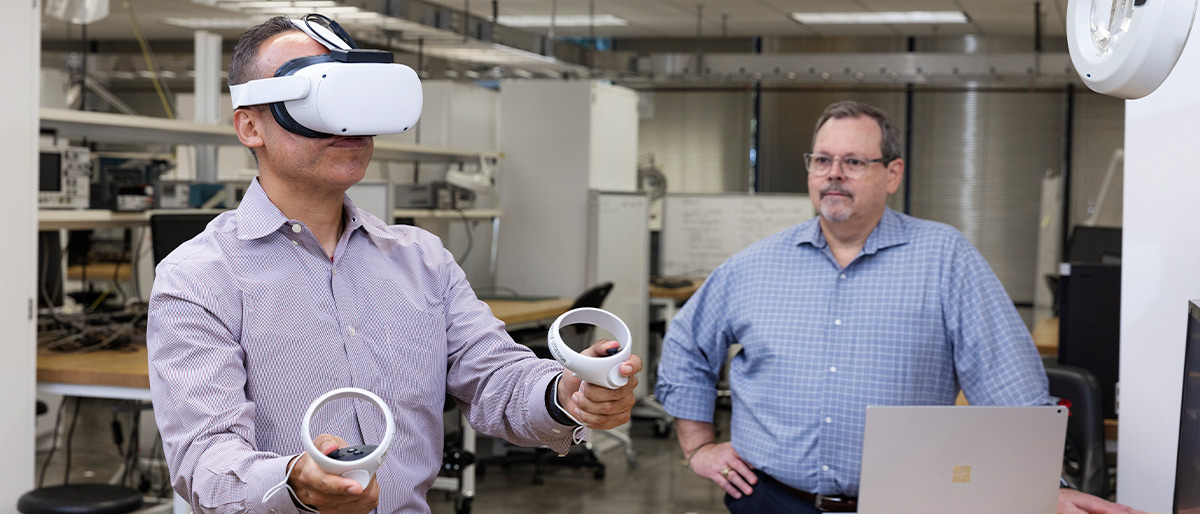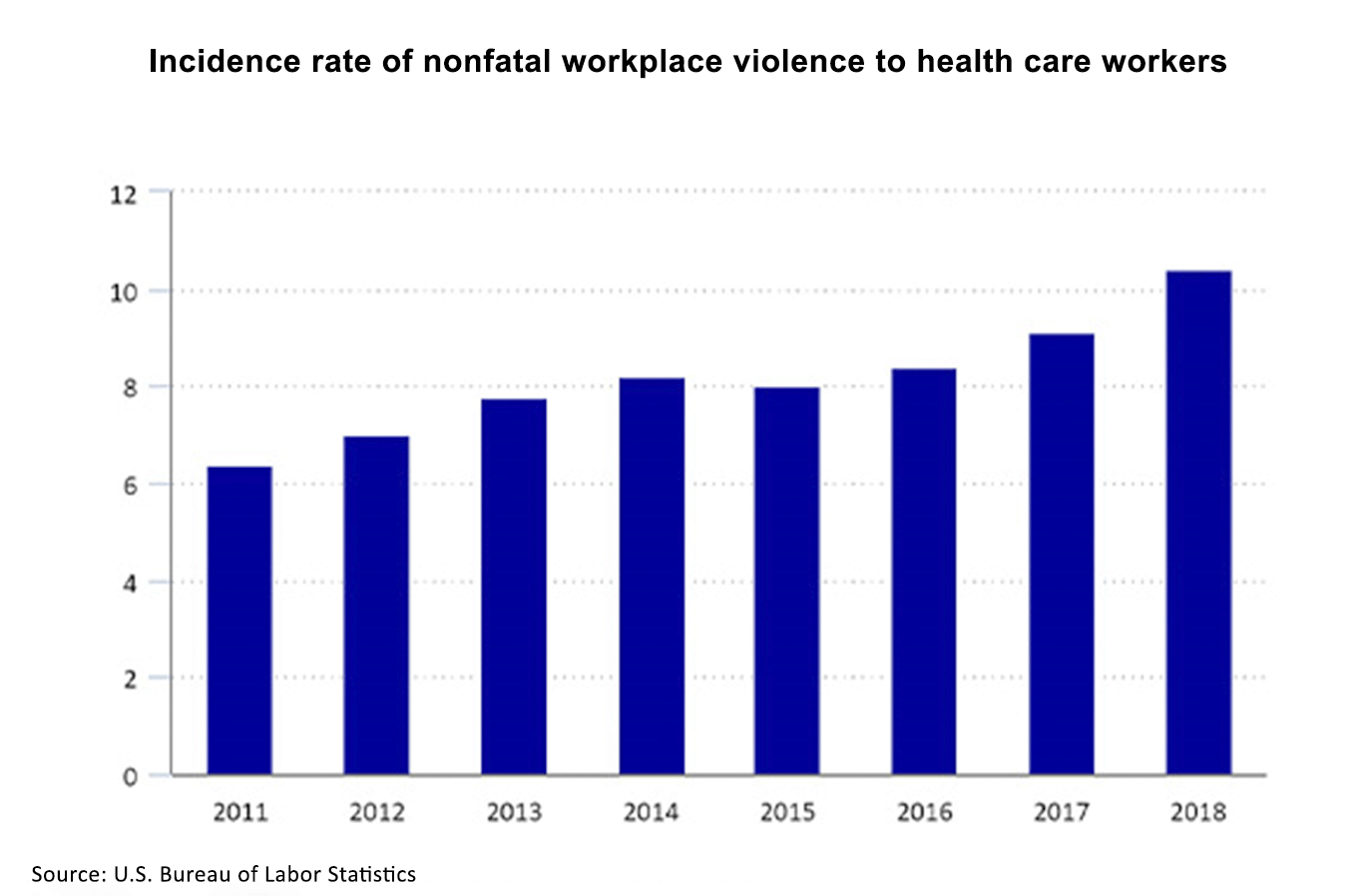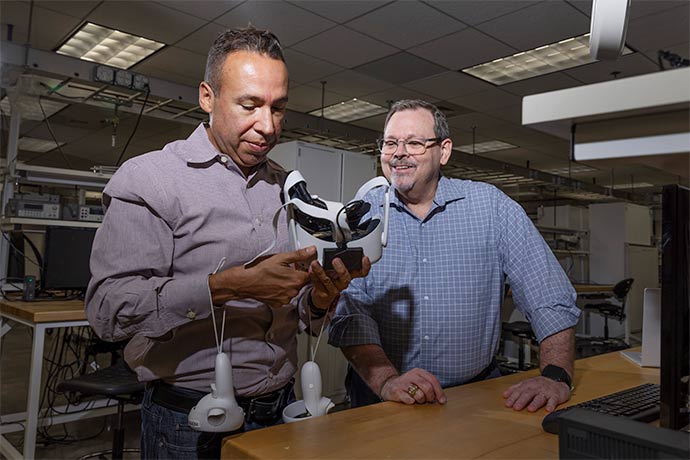UTSW Emergency Medicine group teams with UT Dallas on VR training tool to combat health care workplace violence

As threats against health care workers rise, hospitals are reevaluating safety measures, strengthening the ability of staff to prepare for and respond to aggression. To assist that effort, a team of UT Southwestern Emergency Medicine physicians helped create a training tool that puts health care workers inside a virtual hospital room to practice de-escalation skills for a potentially aggressive individual.
The virtual reality training tool grew out of a need to address workplace violence in an innovative way, said Gilberto Salazar, M.D., Associate Professor of Emergency Medicine and in the School of Health Professions.

Data from the U.S. Bureau of Labor Statistics show health care workers are five times more likely to experience workplace violence than employees in other industries. Such violence can range from verbal abuse to physical violence, and emergency rooms are a frequent epicenter for these altercations. According to a recent survey by the American College of Emergency Physicians, 85% of emergency physicians reported that violence in their workplaces has increased. Two-thirds of the nearly 3,000 emergency doctors polled reported being assaulted in the past year.
“The ongoing exposure to workplace violence is detrimental to the mental and physical health of health care workers,” Dr. Salazar said. “We owe it to ourselves as medical professionals to find better ways to address this issue. Through virtual reality, we can immerse the user in real-life situations and teach them the most effective way to respond.”
Turning to VR technology
To turn their idea into an actual training tool, the team from the UTSW Department of Emergency Medicine partnered with UT Dallas’ UTDesign Program, which pairs regional North Texas companies and organizations with senior UT Dallas engineering and computer science students to solve engineering problems.
The project began with three Emergency Department residents – Andrew Stratton, M.D., Maria Box, M.D., and Philip Jarrett, M.D. – developing a curriculum with instructions on how to recognize the early signs of aggression and de-escalate a situation involving an aggressive individual.

If, for example, someone is rapidly becoming more agitated, the situation will probably not improve if the individual is asked to “calm down,” Dr. Salazar said. Instead, he said, a more effective strategy is for the health care worker to use active listening skills.
The curriculum was based on existing science and evidence developed in various disciplines, including emergency medicine, nursing, psychiatry, and pharmacology. Subtle signals often precede aggressive behavior – but these can be difficult for busy team members to detect, Dr. Jarrett said. VR allows learners to lead simulated patient encounters in a way that rivals reality.
“VR places the user directly into the room, combining intimidatingly realistic scenarios with teachable decision points and iterative practice,” he said. “Unlike traditional products for workplace violence training, VR has the distinct advantage of helping learners feel the intensity of a dangerous situation without the actual threat of harm.”
After the physicians developed a curriculum in which the user chooses how to respond to various situations, UTDesign created a prototype. The team wanted to design a tool that not only put the user in a hospital room, but allowed the person to “feel” what was happening, said Todd Polk, Ph.D., UTDesign Program Director for Bioengineering.
“In the virtual reality world, everything looks almost real,” Dr. Polk said. “The haptic feedback adds another component, so you feel what is happening, which is a big plus.”

While a headset allows the user to “see” what is happening inside the virtual hospital room, a vest and gloves with haptic feedback – mimicking the feeling of touch – make it possible to “feel” what occurs.
“When the VR individual swings at your chest, you actually feel like you’ve been hit,” Dr. Polk said. “You get physical feedback to go along with the virtual reality image.”
Making a virtual idea reality
After development of a prototype, Dr. Salazar applied for a UT Southwestern Simulation Innovation Award, which provides financial support to projects designed to facilitate the growth of state-of-the-art simulation research or curricular design. Upon winning the $10,000 award, Dr. Salazar applied for and was granted Institutional Review Board (IRB) approval to further study health care workplace violence and compare the tool’s effectiveness with other training methods.

The funding award helped pave the way for the next iteration of the VR training module, currently being developed by Austin-based Augmented Training Systems, which will be used for the IRB study scheduled for later this year and potentially for general use at UT Southwestern and elsewhere. The team hopes to eventually make the tool available nationally.
“We believe virtual reality engages learners in an effective way,” Dr. Salazar said. “The current generation of learners respond really well to it.”
Validating the tool through research, testing, and data analysis is the first step. A marketable tool then requires partnership with companies and organizations with the resources and logistics expertise to deploy the tool across the health care industry, Dr. Salazar said.
Although the VR tool was originally designed to be used by health care workers in hospitals, it can be modified for other industries and workplace settings, he added.

